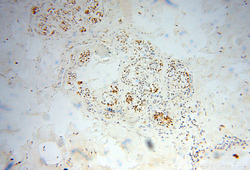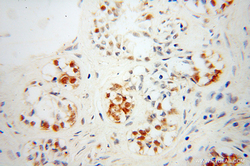Antibody data
- Antibody Data
- Antigen structure
- References [11]
- Comments [0]
- Validations
- Western blot [1]
- Immunohistochemistry [2]
Submit
Validation data
Reference
Comment
Report error
- Product number
- 15817-1-AP - Provider product page

- Provider
- Proteintech Group
- Proper citation
- Proteintech Cat#15817-1-AP, RRID:AB_2257478
- Product name
- XRCC4 antibody
- Antibody type
- Polyclonal
- Description
- KD/KO validated XRCC4 antibody (Cat. #15817-1-AP) is a rabbit polyclonal antibody that shows reactivity with human, rat and has been validated for the following applications: IHC, IP, WB,ELISA.
- Reactivity
- Human, Rat
- Host
- Rabbit
- Conjugate
- Unconjugated
- Isotype
- IgG
- Vial size
- 20ul, 150ul
Submitted references CircUGGT2 facilitates progression and cisplatin resistance of bladder cancer through nonhomologous end-joining pathway.
Curcumin Induces Apoptosis by Suppressing XRCC4 Expression in Hepatocellular Carcinoma.
PARP1 negatively regulates transcription of BLM through its interaction with HSP90AB1 in prostate cancer.
Significant value of XRCC2 and XRCC9 expression in the prognosis of human ovarian carcinoma.
Inhibition of ATM Induces Hypersensitivity to Proton Irradiation by Upregulating Toxic End Joining.
Reciprocal regulation of RIG-I and XRCC4 connects DNA repair with RIG-I immune signaling.
LRIK interacts with the Ku70-Ku80 heterodimer enhancing the efficiency of NHEJ repair.
Silencing of XRCC4 increases radiosensitivity of triple-negative breast cancer cells.
RNase L facilitates the repair of DNA double-strand breaks through the nonhomologous end-joining pathway.
Polychlorinated biphenyl quinone induces oxidative DNA damage and repair responses: The activations of NHEJ, BER and NER via ATM-p53 signaling axis.
5-Azacytidine enhances the radiosensitivity of CNE2 and SUNE1 cells in vitro and in vivo possibly by altering DNA methylation.
Lyu F, Huang S, Yan Z, He Q, Liu C, Cheng L, Cong Y, Chen K, Song Y, Xing Y
Cellular signalling 2024 Jul;119:111164
Cellular signalling 2024 Jul;119:111164
Curcumin Induces Apoptosis by Suppressing XRCC4 Expression in Hepatocellular Carcinoma.
Wang S, Wu W, Liu Y, Xing E, Jiao J, Li L, Li J, Wang D
Nutrition and cancer 2023;75(10):1958-1967
Nutrition and cancer 2023;75(10):1958-1967
PARP1 negatively regulates transcription of BLM through its interaction with HSP90AB1 in prostate cancer.
Huang M, Chen L, Guo Y, Ruan Y, Xu H
Journal of translational medicine 2023 Jul 6;21(1):445
Journal of translational medicine 2023 Jul 6;21(1):445
Significant value of XRCC2 and XRCC9 expression in the prognosis of human ovarian carcinoma.
Liu Y, Xu Y, Jiang M, Chen W, Zhu X
Journal of Cancer 2021;12(20):6254-6264
Journal of Cancer 2021;12(20):6254-6264
Inhibition of ATM Induces Hypersensitivity to Proton Irradiation by Upregulating Toxic End Joining.
Zhou Q, Howard ME, Tu X, Zhu Q, Denbeigh JM, Remmes NB, Herman MG, Beltran CJ, Yuan J, Greipp PT, Boughey JC, Wang L, Johnson N, Goetz MP, Sarkaria JN, Lou Z, Mutter RW
Cancer research 2021 Jun 15;81(12):3333-3346
Cancer research 2021 Jun 15;81(12):3333-3346
Reciprocal regulation of RIG-I and XRCC4 connects DNA repair with RIG-I immune signaling.
Guo G, Gao M, Gao X, Zhu B, Huang J, Tu X, Kim W, Zhao F, Zhou Q, Zhu S, Wu Z, Yan Y, Zhang Y, Zeng X, Zhu Q, Yin P, Luo K, Sun J, Deng M, Lou Z
Nature communications 2021 Apr 12;12(1):2187
Nature communications 2021 Apr 12;12(1):2187
LRIK interacts with the Ku70-Ku80 heterodimer enhancing the efficiency of NHEJ repair.
Wang D, Zhou Z, Wu E, Ouyang C, Wei G, Wang Y, He D, Cui Y, Zhang D, Chen X, Reed SH, Luo J, Chen R
Cell death and differentiation 2020 Dec;27(12):3337-3353
Cell death and differentiation 2020 Dec;27(12):3337-3353
Silencing of XRCC4 increases radiosensitivity of triple-negative breast cancer cells.
Wen Y, Dai G, Wang L, Fu K, Zuo S
Bioscience reports 2019 Mar 29;39(3)
Bioscience reports 2019 Mar 29;39(3)
RNase L facilitates the repair of DNA double-strand breaks through the nonhomologous end-joining pathway.
Zhong Y, Pan B, Zhu J, Fu H, Zheng X
FEBS letters 2019 Jun;593(11):1190-1200
FEBS letters 2019 Jun;593(11):1190-1200
Polychlorinated biphenyl quinone induces oxidative DNA damage and repair responses: The activations of NHEJ, BER and NER via ATM-p53 signaling axis.
Dong H, Shi Q, Song X, Fu J, Hu L, Xu D, Su C, Xia X, Song E, Song Y
Toxicology and applied pharmacology 2015 Jul 1;286(1):10-6
Toxicology and applied pharmacology 2015 Jul 1;286(1):10-6
5-Azacytidine enhances the radiosensitivity of CNE2 and SUNE1 cells in vitro and in vivo possibly by altering DNA methylation.
Jiang W, Li YQ, Liu N, Sun Y, He QM, Jiang N, Xu YF, Chen L, Ma J
PloS one 2014;9(4):e93273
PloS one 2014;9(4):e93273
No comments: Submit comment
Supportive validation
- Submitted by
- Proteintech Group (provider)
- Main image

- Experimental details
- K-562 cells were subjected to SDS PAGE followed by western blot with 15817-1-AP(XRCC4 antibody) at dilution of 1:1000
- Sample type
- cell line
Supportive validation
- Submitted by
- Proteintech Group (provider)
- Main image

- Experimental details
- Immunohistochemical of paraffin-embedded human breast cancer using 15817-1-AP(XRCC4 antibody) at dilution of 1:100 (under 10x lens)
- Sample type
- tissue
- Submitted by
- Proteintech Group (provider)
- Main image

- Experimental details
- The XRCC4 antibody from Proteintech is a rabbit polyclonal antibody to a recombinant protein of human XRCC4. This antibody recognizes human, rat antigen. The XRCC4 antibody has been validated for the following applications: ELISA, WB, IHC analysis.
 Explore
Explore Validate
Validate Learn
Learn Western blot
Western blot ELISA
ELISA